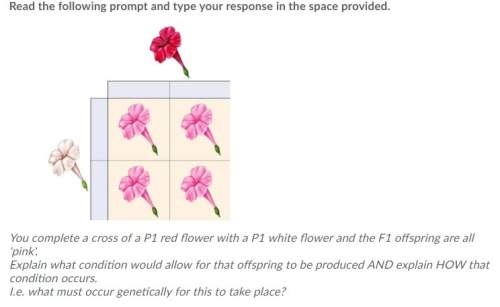
Biology, 28.06.2021 22:40 shartman22
Which of the following accurately describes a cause-and-effect relationship,
based on information in the passage?
O A. The different finch populations have different beak shapes.
Consequently, they chose to populate different islands.
O B. A small population of finches landed on an island with different
plants. As a result, finches with beak shapes that allowed them to
eat on the island survived.
O c. Because Darwin observed the beaks and behavior of finches, he
boarded the HMS Beagle for a five-year voyage.
O D. The finches left the South American mainland in order to find food
on the islands.

Answers: 2


Another question on Biology

Biology, 21.06.2019 20:00
Sampling lake water for microscopic organisms is not as easy as it sounds when you want to both count and identify species. in a given water sample, your bacteria of choice can be rare or difficult to culture, particularly given the mixture of bacteria in a biofilm. which of the following culture media would be best for growing fecal coliforms when they are relatively less abundant than other bacteria in the lake? anaerobic culture medium enrichment culture medium complex culture medium basic culture medium
Answers: 1

Biology, 22.06.2019 04:00
Will mark brainliest i only need the ! 1.use ten beads and a centromere of one color to construct the long chromosome. use ten beads and a centromere of a second color to construct the second chromosome in the long pair. make a drawing of the chromosomes in the space below. 2. for the second pair of chromosomes, use only five beads. 3. now model the replication of the chromosomes. make a drawing of your model in the space below. part b: meiosis i during meiosis i, the cell divides into two diploid daughter cells. 4. pair up the chromosomes to form tetrads. use the longer tetrad to model crossing-over. make a drawing of the tetrads in the space below. 5. line up the tetrads across the center of your “cell.” then model what happens to the chromosomes during anaphase i. 6. divide the cell into two daughter cells. use the space below to make a drawing of the result. part c: meiosis ii during meiosis ii, the daughter cells divide again. 7. line up the chromosomes at the center of the first cell, one above the other. separate the chromatids in each chromosome and move them to opposite sides of the cell. 8. repeat step 7 for the second cell. 9. divide each cell into two daughter cells. use the space below to make a drawing of the four haploid cells
Answers: 1

Biology, 22.06.2019 05:30
2. sketch the inside of the bean nodule, and describe or label what you observed with the hand lens.
Answers: 2

Biology, 22.06.2019 07:20
Some tools have graduations to show multiple measurements. for example, a ruler may have graduations for both millimeters and centimeters. when measuring the length of an earthworm, which graduations would allow for the most accurate measurement? millimeters centimeters decimeters meters
Answers: 2
You know the right answer?
Which of the following accurately describes a cause-and-effect relationship,
based on information i...
Questions


Mathematics, 24.09.2021 09:10



English, 24.09.2021 09:10




English, 24.09.2021 09:10


Mathematics, 24.09.2021 09:10





Mathematics, 24.09.2021 09:10







